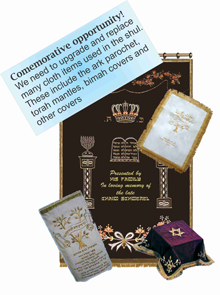Tisha B’Av is a full day fast (sunset to sunset) commemorating the destruction of both the 1st Temple (destroyed by the Babylonians in 586 BCE) and 2nd Temple (destroyed by the Romans in 70 AD).
However, the purpose of fasting on Tisha B’Av is not simply to recall history. The Rambam, in his section called Laws of fasting explains in greater detail the reason for fasting.
The reason that the prophets ordained fast days is to reflect on the mistakes made by our ancestors. It was those mistakes which were the catalyst for the tragedies which occurred on these days. Unfortunately we perpetuate these mistakes in our own days. The purpose of fasting is an attempt to avoid repeating these errors.
The Talmud states that the first temple was destroyed because of idol worship, sexual immorality and murder. The second temple was lost due to unjustified hatred.
Today, society is still rife with this conduct. Full redemption will only come with a return to the values Torah demands of us.
A famous commentary on Meggilat Eicha was written by Rabbi Moshe Alshich called “words of comfort.” Often referred to as “The Alshich,” Rabbi Moshe Alshich was born in Turkey in 1507 and in 1535 moved to TZFAT where he soon became famous for his understanding of TORAH.
Interestingly he chose to call his commentary on EICHA “Words of Comfort” rather than “Words of Lament” which would seem to have been more appropriate. He explains in his introduction that even though we, the Jewish people have sinned and therefore lost our land and temple, since G-D loves us so dearly he will redeem us once again in the future.
He continues to explain that as a result of Hashems affection for us he destroyed his own temple rather than destroying his own people.
May we all merit to see the rebuilding of the Temple and coming of the Messiah speedily in our days.
The first Temple (built by King Solomon) was destroyed by the Babylonians on this day, in the year 586 BCE. Many hundreds of years later, the second Temple was destroyed by the Romans (70AD), also on the 9th of Av.
All that remains of the Temple today is a portion of the outer wall of the second Temple, today known as the Kotel or the Wailing Wall, which has assumed tremendous importance to Jews all over the World.
When the Jews recaptured the Western Wall during the Six Day War in 1967 it gave us renewed hope that our prayers would be fulfilled by G-d and that one day with the coming of Messiah the Temple will be rebuilt and our joy will be complete.
The month of Av is also called Menachem Av, (Menachem meaning comfort). This is in anticipation of the consolation which we hope will materialize in the month pof Av. Some people have the custom of only mentioning the name Av until Tisha B’Av, thereafter using the term Menachem Av.
Twenty- one days before Tisha B’Av is a half day fast from Sunrise to Sunset on the 17th Tammuz, which marks the first breach in the walls of Jerusalem during the time of the first Temple. The 17th Tammuyz also marks the day on which Moses descended for the first time from Mount Sinai, and broke the Tables on which the Ten Commandments were written. ON this day the daily Sacrificial Offering during the time of the first Temple ceased. This period of time from the 17th Tammuz until the 9th of Av is known as “The Three Weeks”.
Customs during the Three Weeks
During the three week period, weddings are not permitted, nor are any other celebrations and festive gatherings, particularly if accompanied by music. (Barmitzvahs can be celebrated, as long as there is no music at the function). One is also not permitted to cut one’s hair during this period. A person may also not buy new clothes during this period even if he intends to wear them after Tisha B’Av.
From Rosh Chodesh Av until Tisha B’Av is a period known as the nine days. During these days the mourning period is more intense and it is customary not to drink wine, or eat meat or poultry, in addition to all the other laws of the three weeks.
However on Shabbat it is permitted to eat meat, poultry and drink wine. (It would also be permitted for a Bris).
There is also the custom of not planting trees for shade during the nine days.
TISHA B’AV IS A FULL DAY FAST AND HAS MANY LAWS AND CUSTOMS.
Listed below are a few associated with it:
- Tisha B’Av is a full day fast. In the Jewish calendar we have two types of fasts days. There are those Fast days that are written in the Torah and Fast days that were instituted by the Rabbis. The only fast day mentioned in the Torah is Yom Kippur which is a full day fast, from Sunset to Sunset. Fast days instituted by the Rabbis fall into 2 categories:
- Half day Fasts from Sunrise to Sunset.
- Full day fasts from Sunset to Sunset.
The only full day fast instituted by the Rabbis is the Fast of AV.
The Fast of Esther is an example of a half day Fast.
- At the Seudah Mafseket (last meal) before the fast, it is customary to eat a hard-boiled egg with a bit of ash placed on top of it, as a sign of our mourning and of the Temple which was burned down to ashes. The meal is eaten by each person alone, so that there should be no Zimun (at Grace after meals afterwards).
- In Shul, after Maariv, the Book of Lamentations (Megillat Eicha) is read in the mournful chant traditionally associated with it with the worshippers sitting on the ground or low stools.
- Kinnot- The Kinot are read on the morning of Tisha B’Av. The Book of Kinot was composed during the Middle Ages and reflects not only the destruction in ancient times but also the sufferings of the People pf Israel in exile, especially the destruction of many Jewish communities in Germany during the time of the Crusades.Another topic of the Kinot is Jerusalem in its destruction, among them the famous moving lament by Rabbi Yehudah Halevi “Tziyon halo tishali lishlom assirayich – Zion, will you not ask of the welfare of your exiles?”
After the Kinot, Lamentations is read once again. - To emphasise the mournful character of the day, it is customary to remove the parochet , the curtain form the Holy Ark, and the decorative cover form the Reader’s table, providing a stark appearance. (In some communities, the Ark is draped in black). It is customary in some Communities to extinguish most of the lights reciting Eicha by the dim lights of candles held by worshippers.
- We do not greet eachother with the word “Shalom”.
- Because a Talli and Tefillin are religious adornments, symbols of beauty, neither is worm at the morning service of Tisha B’Av. They are instead put on for afternoon Mincha Service. This is the only occasion when tefillin is not worn in the morning.
- Other customs adhered to on TIsha B’Av are the abstaining from wearing leather shoes, and shaving (and women from their cosmetics).
Over the course of the Jewish year, there are five books that are associated with specific holidays.
These megillot (scrolls) relate the event that took place on the particular holiday or reflect the message of the occasion. The most of familiar is the scroll of Esther, which is read on Purim. The book of Eicha (Lamentations) is reading on the Ninth of Av. The book begins with the word “eicha,” meaning “how”–the first word of the opening verse, “How lonely sits the city once full of people.” This refers to Jerusalem after the destruction of the Temple. Lamentations is traditionally attributed to the prophet Jeremiah who witnessed the destruction of the first Temple.
The Book of Lamentations describes Jerusalem under siege and of the destruction of the First Temple. The elegy bewails Jerusalem, once teeming with life and now sitting abandoned and alone like a solitary widow. It captures the horror of the siege: children pleading for water and bread in vain; cannibalism on the part of hunger-maddened mothers (“those who died by the sword were better off than those who perished by hunger”); nobles hanged; women raped; priests defiled.
The prophet basically blames Jewish immorality and idolatry for the tragedy. Yet there is a fascinating outburst in Chapter 3 in which the believer, as it were, accuses God of being the enemy–like a lion lying in ambush to destroy his victim. The prophet comes close to losing his faith (“I thought my strength and hope in the Lord had perished”) before the memory of God’s past kindnesses restores it–barely.
The Book of Lamentations is read softly at first. The volume of the reader’s voice builds to the climax, which is sung aloud by the entire congregation: “Turn us to you, O Lord, and we will return. Renew our days as of old.”
The above was taken from the internet site: My Jewish Learning
The Shabbat before the 9th of Av is called Shabbat Chazon. The Haftorah on the day – from the Book of Yeshayahu begins with the words Chazon Yeshayahu 9the Vision of Yeshayahu) and hence the Shabbat received its special name. The Haftorah is said in the mournful chant used for Megillah Eicha.
The Shabbat following the 9th of Av is called Shabbat Nachamu, the Shabbat of Comfort. It gets its name form the first words of the Haftorah, Nachamu, Nachamu – Comfort oh Comfort.
OTHER CALAMATIES THAT OCCURRED ON THE 9th of AV
- On the 9th of Av it was decreed that the Children of Israel, after the Exodus from Egypt should not enter the Promised Land. (Only after wandering for 40 years in the desert).
- Betar, the last stronghold of the leaders of Bar Kochba War, was captured in 135 CE.
- In the year 136 C.E. the Roman Emperor Hadrian established a heathen temple on the site of the Temple and rebuilt Jerusalem as a pagan city, which the Jew were forbidden to enter.
- The first crusade brought death and destruction to Jewish communities up and down the Rhine Valley in 1096.
- Jews were expelled from England in 1290.
- The Jews were expelled from France in 1306.
- The expulsion of the Jews from Spain in 1492 also occurred on the 9th of Av.
- Chmielnitzki’s hordes massacred thousand of Polish Jews in 1648.
The 9th of Av thus became a symbol for all the persecutions and misfortunes of the Jewish People, for the loss of national independence and sufferings of exile.
There is no mourning in Jewish tradition without the comfort and consolation of Redemption, no destruction without the hope of revival to follow it.
According to Jewish tradition the Messiah will be born on TIsha B’Av. For this reason by the afternoon the mourning customs are relaxed – we put on Tallit and Tefillin at Mincha and return to our regular places at shul.
May we merit to see the coming of the Messiah speedily in our time.










